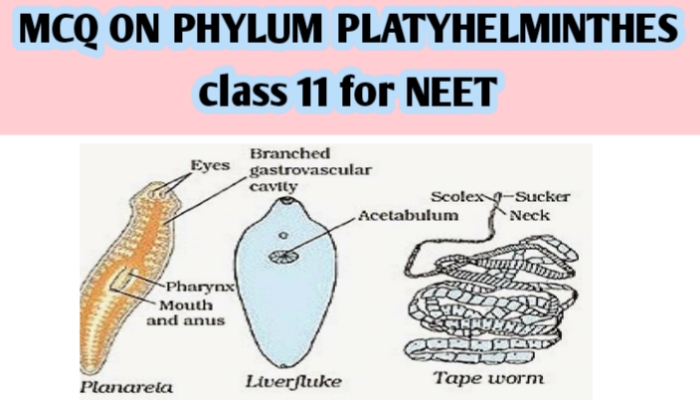MCQ ON PHYLUM PLATYHELMINTHES class 11 for NEET | MCQ ON NEET Biology class 11th 2022 | MCQ Questions for class 11 Biology chapter 4 PHYLUM PLATYHELMINTHES with Answer | Check the below NCERT MCQ question for class 11 Biology chapter 4 based on PHYLUM PLATYHELMINTHES with Answers.
MCQ Questions for class 11 Biology with Answers were prepared based on the latest pattern.We have provided class 11 Biology MCQs questions on PHYLUM PLATYHELMINTHES with Answers to help students understand the concept very well.

MCQ ON PHYLUM PLATYHELMINTHES class 11 for NEET
MCQ on Phylum PLATYHELMINTHES is useful for NEET/CSIR/UGC/CBSE/ICSE /AIIMS EXAM/AFMC EXAM/STATE LEVEL MEDICAL EXAM 2022-23
Introduction:-
The phylum Platyhelminthes includes the flatworms.They are the most primitive bilateral animals .The body is soft and dorsoventrally flattened.The symmetry is bilateral in flatworms.This is triploblastic animals.It possess organ level organisation , cephalization starts in this phylum.There are no locomotary appendages in flatworms.
MCQ ON PHYLUM PLATYHELMINTHES class 11 for NEET
1.Phylum -Platyhelminthes having dorso- ventrally flattened body , hence are called
(a) flatworms
(b) Cnidaria
(c) comb plate
(d) sponge
Ans (a) flatworms
2.They are mostly endoparasites found in animals including human beings ?
(a) Ctenoplana
(b) comb jellies
(c) Cnidaria
(d) Platyhelminthes
Ans. (d) Platyhelminthes
3.Flatworms are type of symmetrical
(a) bilateral
(b) monolateral
(c) trilateral
(d) both a and b
Ans. (a) bilateral
4.Flatworms are
(a) triploblastic
(b) cellular level
(c) tissue level
(d) monoblastic
Ans.(a) triploblastic
5.Flatworms are acoemalate animals with
(a) cell level organisation
(b) tissue level organisations
(c) organ level organisation
(d) all the above
Ans.(c) organ level organisation
ALSO READ:-
● YOU CAN WATCH BIOLOGY SIR Youtube channel
6. Hooks and suckers are present in flatworms are in the ?
(a) parasitic forms
(b) Pleurobrachia
(c) non parasitic forms
(d) nutritient
Ans.(a) parasitic forms
7.Specialised cells help in osmoregulation and excretion
(a) flame cells
(b) nephridia
(c) skin
(d) kidney
Ans.(a) flame cell
8.Fertilisation in flatworms is
(a) internal
(b) external
(c) both a and b
(d) none of the above
Ans.(a) internal
9.Member of flatworms posses high regeneration capacity .
(a) hydra
(b) flatworms
(c) planaria
(d) taenia
Ans. (c) planaria
10. Liver fluke is
(a) Taenia
(b) Fasciola
(c) planaria
(d) Ctenophora
Ans. (b) Fasciola
11.Tapeworm is
(a) Taenia
(b) Fasciola
(c) planaria
(d) flatworms
Ans.(a) taenia
12.Respiration in flatworms takes place through
(a) skin
(b) gill
(c) lung
(d) general body surface
Ans.(d) general body surface
13.Turbellaria , Trematoda and Cestoda classes are in phylum
(a) Ctenophora
(b) Arthropod
(c) Cnidarian
(d) Platyhelminthes
Ans.(d) Platyhelminthes
14.The turbellarias are mostly free – living .They are commonly called the
(a) flatworms
(b) planarians
(c) dugesia
(d) Fasciola
Ans.(b) planarians
15. The blood fluke is ?
(a) Fasciola
(b) taenia
(c) Trematoda
(d) Schistosoma
Ans. (d) Schistosoma
16.The pork tapeworm is ?
(a) Fasciola
(b) taenia solium
(c) liver fluke
(d) cestoda
Ans.(b) taenia solium
17. The beef tapeworm is
(a) Taenia saginata
(b) taenia solium
(c) liver fluke
(d) none of the above
Ans.(a) Taenia saginata
18. Fasciola live in the bile ducts of the liver of
(a) sheep
(b) goat
(c) both a and b
(d) cow
And.(c) both a and b
19.Fasciola hepatica lives in the sheep’s
(a) blood
(b) liver
(c) bile duct
(d) intestine
Ans. (c) bile duct
20.The organ system of flatworms are packed in a characteristic connective tissue called the
(a) Ctenophora
(b) parenchyma
(c) collenchyma
(d) Cnidarians
Ans.(b) parenchyma







Leave a Comment